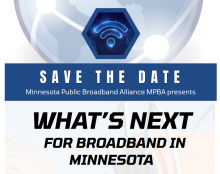By
on

Minnesota is now in poor company, along with several other states that have chosen to use telecom industry-backed Connected Nation (if unfamiliar with CN, read this report) to supply data from Minnesota to the federal government as part of the national broadband map that is being constructed.
Just how this came about explains why a group like Connected Nation thrives in the current telecommunications arena.
Mike O'Connor, the urban users' representative on the Minnesota Governor's Broadband Task Force, explains that the Minnesota Department of Commerce and Department of Employment and Economic Development (DEED) chose Connected Nation absent any public discussion or even consultation of the broadband task force.
Mike is not one to mince words about the deal (which got him picked up by MinnPost):
I'm pretty cranky about this process. Nice n'cozy. Nice n'closed. Nice bypass of the Task Force. No public input at all as far as I can see. Looks like there was lots of opportunity for providers to provide input about their confidentiality needs, not too much input about what consumers need. Look forward to more sub-par optimistic maps, and impossible to use/verify data, peepul.He references the ample opportunity for providers to express their preferences, this comes from the letter from the two commissioners to the governor:
The other primary reason that we are recommending Connected Nation is that in conversations with and letters from the broadband provider community (including the Minnesota Telecom Association, the Minnesota Cable COmmunications Association, Qwest and Comcast), they have noted their satisfaction with the work Connected Nation as done, the professionalism displayed. Most important, the providers have confidence in Connected Nation's ability to protect their sensitive, nonpublic infrastructure information.The letter goes on to discuss the other possible mapping entity - the University of Minnesota:
First, the University indicates that it has entered into confidentiality agreements on other projects. However, in speaking with the provider community, it is unclear whether they would be able to reach agreement with the University on nondisclosure agreements (NDAs) in order to turn their infrastructure data over to the University.So let's clarify all this.
- Broadband providers across the United States, mostly large private companies like Comcast and Verizon, have failed to invest in the broadband infrastructure we need.
- In order to discover the magnitude of the problem, we are developing a massive map to show where these companies fail to offer services needed by communities.
- To gather this data, many states are using Connected Nation, a group created and heavily influenced by these same companies.
- We are to believe that Connected Nation does a good job because the providers like working with Connected Nation (a group supposedly tasked with demonstrating their shortcomings).
- We cannot use anyone but Connected Nation because the providers do not want to give this data to anyone but Connected Nation (because it is a secret if you are getting the rates they advertise).
In the section of the bid asking for references, Connected Nation included recommendations for Connect Minnesota, from Diane Wells of the Minn. Department of CommercePhoto by Jackanapes, used under creative commons license.







